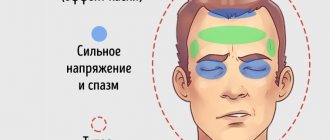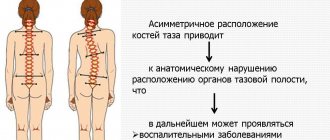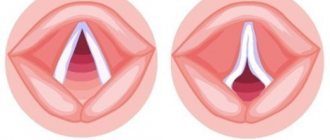NEUROSIS: How to relieve constant tension in the head
When treating this symptom, an integrated approach is used that helps reduce its intensity and remove the cause of the neurotic disorder. Several types of assistance are used for this.
In life, a person faces various situations that strain his nervous system: there is no way to respond to grievances, fear arises due to a lack of a sense of security, it is not possible to implement plans, and so on. All conflict situations and shocks do not remain without a trace in the body.
As a result of the action of psychotraumatic factors, a person develops the disease neurosis . It begins almost imperceptibly and manifests itself differently in everyone.
Symptoms and external manifestations of the disease depend on the duration of the traumatic situation, its severity and individual reaction to it.
What is neurosis?
Neurosis is a disease in which a person loses the ability to cope with stressful situations .
The body’s defenses and the formed psychological adaptation “break down” in this state, leading to exhaustion of the nervous system.
This disease affects not only the psyche and the nervous system; a person often notices a malfunction of an internal organ or prolonged pain.
Subscribe to our INSTAGRAM account!
Strong neurosis does not go unnoticed from the outside either. People around note increased irritability and deterioration in the physical condition of a person suffering from this disease.
Causes of the disease
- An interesting fact is that not only situations associated with the loss of something close can lead to neurosis. The cause of the disease can also be a bright, joyful event , for example, the birth of a child, a wedding, or the start of studies at the desired college or university.
- Neurosis often occurs in melancholic and choleric people. These types of temperament are characterized by emotional instability, so typical melancholic and choleric people have a more difficult time experiencing traumatic situations.
- Physical and psycho-emotional stress ultimately lead to this nervous pathology. If a person constantly works or studies and does not have enough time for relaxation and rest, he is at risk. Especially with accompanying problems in your personal life, the development of neurosis cannot be avoided.
- With long-term or intense somatic illnesses, psychological problems associated with the inability to finish the work started, symptoms of severe neurosis also appear.
How does this disease manifest itself?
A neurotic disorder of the nervous system necessarily leads to detrimental consequences for the body and social activity of a person.
It can cause neurosis, nausea, dizziness, constant headaches, increased conflict, irritability, and disability.
That is why, when neurosis manifests itself, you need to solve the problem, and not hope for its independent disappearance .
The main manifestations of the disease include:
- headaches of various types;
- numbness of the limbs;
- dizziness;
- various types of sleep disorders;
- a person cannot relax if he wants to;
- increased irritability;
- the patient does not feel joy and happiness, he is constantly depressed;
- restlessness, anxiety;
- decrease in cognitive functions, intellectual abilities;
- fast fatiguability;
- pain in internal organs, in the limbs, without obvious reasons;
- decreased labor productivity;
- mood swings;
- tearfulness;
- touchiness;
- “getting stuck” in a stressful situation;
- the body's sensitivity to temperature changes and bright light;
- disorders of the autonomic nervous system: sweating, rapid heartbeat, fluctuations in blood pressure, problems with the stomach;
- decreased sex drive;
- decrease in the intensity of volitional impulses;
- dyspnea;
- dark spots when closing or opening the eyes, the condition is accompanied by dizziness;
- decreased appetite, inability to form a bolus due to insufficient amount of saliva in the mouth;
- the appearance of a feeling of fear without a threatening factor.
Reduced severity of physiological symptoms
The listed signs manifest themselves differently in each patient. For some, neurosis is accompanied by only a few symptoms of the listed manifestations, and some note almost all of the listed changes in their body. Among the common symptoms, patients note headache, nausea, dizziness, tension in the body and head.
Tension in the body
This is the main companion of the disease. Neurotic disorders are almost always accompanied by muscle tension. This phenomenon occurs for both physiological and psychological reasons. In the human body, an uneven distribution of muscle load occurs, and dystonic reactions appear.
Some researchers argue that tension in any part of the body is associated with specific psychological problems. For example:
- Feelings of hostility towards others lead to tense arm muscles.
- Increased muscle tone in the thighs and pelvis in adulthood is caused by sexual problems.
- Tension in the head during neurosis is caused by deep emotions, unresolved conflicts, and low self-esteem of a person.
Psychological problems are very closely related to somatic manifestations. That is why it is necessary to get rid of this symptom as part of a set of measures to overcome a neurotic disorder.
With neurosis, constant tension in the body is treated not only with medications, but also with active use of physical exercises. They are prescribed depending on which muscles cannot relax. The following would be appropriate here:
- relaxation massages;
- various water treatments;
- medications for severe symptoms;
- working with a psychologist, psychotherapist to solve the cause of muscle tightness.
Nausea with neurosis
Not all doctors associate this symptom with psychological problems.
Only experienced gastroenterologists or therapists refer the patient for a consultation with a psychotherapist or neurologist when experiencing nausea.
Nausea with neurosis can last from several hours to several days. And it should not be associated with low-quality food and take sorbents or bacteria for the intestinal flora - there will be absolutely no result.
Constant nausea in neurosis is often observed with a feeling of disgust towards an object, person or activity, if the patient has accumulated grievances, he is dissatisfied with his life, his health or appearance. Constantly interacting with what a person considers unworthy or bad, neurosis will manifest itself through the main symptom - nausea.
There are two treatment options:
- reducing the severity of symptoms, short-term techniques using antipsychotics or antidepressants;
- long-term psychotherapy aimed at eliminating not only the symptom, but also the causes of neurosis.
Dizziness with this disease
It is enough to associate this phenomenon with the pathology of the nervous system, since dizziness during neurosis is not always accompanied by problems with internal organs. A person may complain of weakness and dizziness, although when tested, all results will be within the normal range; blood pressure measurements will also not show any pathology. In this case, we can safely say that the symptom is caused by psychogenic causes.
Dizziness occurs with depression, panic attacks, vegetative-vascular dystonia, phobias, and anxiety. It is complemented by noise in the head, increased irritability and sleep disorders. With dizziness of a psychogenic nature, it is impossible to cure a person of them without the use of psychotherapeutic techniques.
If dizziness is accompanied by hearing problems and gait disturbances, then we may be talking about disturbances in the functioning of the vestibular apparatus. In this case, an ENT doctor provides assistance.
With changes in blood tests and examinations of the cardiovascular system, dizziness is caused by neurological or vascular diseases.
A doctor working with a patient cannot immediately diagnose psychogenic dizziness, so first a negative diagnosis should be made - eliminating the physiological causes of the symptom.
In the treatment of dizziness due to neurosis, medications, special gymnastics and breathing exercises, as well as psychotherapeutic techniques are used.
Headache due to neurosis, causes
Headache is a faithful companion of neurasthenia and hysteria; it is practically not observed in obsessive-compulsive neurosis. This symptom does not occur immediately after a stressful situation, but after a certain period of time, after the development of other symptoms, for example, sleep or appetite disorders.
Headache with neurosis manifests itself in different ways, depending on the location of pain and the human organs involved. It develops due to:
- Muscle “clamps”.
- Disturbances in the functioning of cerebral vessels.
- Without disruption of muscles and blood vessels.
As a result of this classification, the symptoms of headaches with neurosis will be slightly different.
Neuromuscular pain is accompanied by:
- feeling of squeezing of the head;
- numbness of some parts of the surface of the head;
- sensation of pain on the skin surface of this part of the body;
- a person feels constant tension in the head, which interferes with mental processes: it is difficult to remember something, concentrate attention, or decide.
The neurovascular nature of pain will be expressed through the following symptoms:
- throbbing pain in the head;
- pulsation constantly focuses a person’s attention on pain, he cannot perform any complex mental work;
- often localized in the temporal region, occipital and frontal;
- accompanied by nausea and weakness.
Headache without muscle tension and pulsation in a neurotic disorder occurs after overwork. It does not have a clear localization, and it is difficult to understand the nature of the pain. Its occurrence is associated with psycho-emotional experiences, so it is classified as neurotic symptoms.
How to get rid of neurotic headaches?
It is important for patients with a neurotic disorder to know how to relieve tension and pain in the head during neurosis, because their livelihoods depend on it. When treating this symptom, an integrated approach is used that helps reduce its intensity and remove the cause of the neurotic disorder. To achieve this, several types of patient assistance are used.
Subscribe to our VIBER channel!
Medication assistance
With neuroses, pain in the head can be simply unbearable. A constant feeling of heaviness, constriction and increased severity of pain leads to a deterioration in the patient’s psycho-emotional state.
He becomes irritable, gets tired quickly, and does not want to use anything for food, since the chewing process also causes pain. To solve this problem, it is necessary to use medications to get rid of headaches.
To do this, the doctor prescribes:
- sedative herbal preparations (Valerian, Peony Tincture, preparations with motherwort, Nervo-Vit);
- painkillers that relieve muscle or vascular spasm (Spazmolgon, Riabal, Novigan, various analgesics and others);
- vitamins to support the functioning of the heart and nervous system (various vitamin complexes with vitamins C, group B, magnesium, iron and other microelements);
- nootropics and anti-anxiety drugs (Glycised, Glycine, Nootropil, Pantogam), they have a good effect on brain function and normalize sleep, but the dosage and course of administration are determined only by a doctor.
Psychotherapeutic assistance
Psychological techniques are used not only to treat headaches, but also to get rid of the causes of neurosis. Cognitive behavioral therapy is actively used, hypnosis is an effective assistant, and it is also important to use positive therapy methods to restore a person’s psycho-emotional sphere. Long-term work with a psychologist or psychotherapist is required.
Lifestyle change
Often a person causes himself to develop neurotic headaches by exposing himself to excessive mental or physical stress.
To avoid the development of this symptom into pathology, restoration of the body's strength is required: healthy sleep, work and rest regime, you can help yourself by using aromatherapy, therapeutic exercises, doing massages, water procedures, tuning into the positive and learning positive thinking. Published by econet.ru.
on the topic of the article here
PS And remember, just by changing your consciousness, we are changing the world together! © econet
Source: https://econet.ru/articles/nevroz-kak-snyat-postoyannoe-napryazhenie-v-golove
Characteristic symptoms
The first symptoms of neurasthenia are:
- insomnia;
- headache;
- fatigue;
- heart rhythm disturbances;
- decreased memory and attention;
- increased emotionality;
- pressure and temperature surges;
- heaviness in the head;
- dizziness.
The course of the disease has three forms, each of which is characterized by its own corresponding symptoms:
- hypersthenic syndrome;
- irritable weakness;
- hyposthenic syndrome.
At the first stage, the patient experiences increased irritability and excitability, and frequent mood swings. Such people quickly lose their temper, are capable of insults without reason, and are impatient. Performance decreases, which becomes even more annoying.
A form of irritable weakness manifests itself in patients with a stable psyche who have made no attempts to treat the disease at the first stage. Characteristic features:
- change from bad mood to moral or physical exhaustion;
- causeless screaming;
- emotional reaction even to minor problems;
- restlessness;
- nervous weakness;
- complete exhaustion.
The third stage of pathology includes hyposthenic syndrome. In some cases, it may occur without the manifestation of the first two forms. This phenomenon is observed in patients with a labile nervous system. Main symptoms:
- apathy;
- persistent weakness;
- anxiety;
- sadness;
- emotional instability;
- tearfulness.
Cerebral neurasthenia may also have a connection with the cardiovascular system. The patient experiences tachycardia, pain in the abdominal area, redness of the skin, and arterial hypertension. The manifestation of such signs occurs suddenly, which can be caused by even slight excitement.
How to relieve tension in the head and body during neurosis: constant dizziness and pain
Friends, let’s get straight to the point: relieving neurosis and its nasty symptoms in the head is done through -
Attention ! I really don’t recommend (or rather, I completely forbid) self-treatment. Without knowing the dosages of drugs, you can climb into such a hole as you feel from an overdose, which will not seem like much. Therefore, put your feet up and go to the doctor.
And now - in more detail.
In life, a person faces various situations that strain his nervous system: there is no way to respond to grievances, fear arises due to a lack of a sense of security, it is not possible to implement plans, and so on.
All conflict situations and shocks do not remain without a trace in the body. As a result of the action of psychotraumatic factors, a person develops a disease called “neurosis” .
It begins almost imperceptibly and manifests itself differently in everyone.
Symptoms and external manifestations of the disease depend on the duration of the traumatic situation, its severity and individual reaction to it.
Neurosis can cause severe headaches
Headache due to neurosis and its causes
Headache is a faithful companion of neurasthenia and hysteria, but it is practically not observed in obsessive-compulsive neurosis.
This symptom does not occur immediately after a stressful situation, but after a certain period of time, after the development of other symptoms, for example, sleep or appetite disorders.
Headache with neurosis manifests itself differently depending on the location of pain and the human organs involved.
Worth seeing: Lump in throat due to neurosis
It develops due to:
- Muscle “clamps”.
- Disturbances in the functioning of cerebral vessels.
- Without disruption of muscles and blood vessels.
As a result of this classification, the symptoms of headaches with neurosis will be slightly different.
Neuromuscular pain is accompanied by:
- feeling of squeezing of the head;
- numbness of some parts of the surface of the head;
- sensation of pain on the skin surface of this part of the body;
- a person feels constant tension in the head, which interferes with mental processes: it is difficult to remember something, concentrate attention, or decide.
The neurovascular nature of pain will be expressed through the following symptoms:
- throbbing pain in the head;
- pulsation constantly focuses a person’s attention on pain, he cannot perform any complex mental work;
- often localized in the temporal region, occipital and frontal;
- accompanied by nausea and weakness.
Headache without muscle tension and pulsation in a neurotic disorder occurs after overwork.
It does not have a clear localization, and it is difficult to understand the nature of the pain.
Its occurrence is associated with psycho-emotional experiences, so it is classified as neurotic symptoms.
Overwork can also cause headaches
How to get rid of neurotic headaches?
It is important for patients with a neurotic disorder to know how to relieve tension and pain in the head during neurosis, because their livelihoods depend on it.
When treating this symptom, an integrated approach is used that helps reduce its intensity and remove the cause of the neurotic disorder.
To achieve this, several types of patient assistance are used.
Who are a neurasthenic and a neurasthenic?
People suffering from neurasthenia are not always easy to recognize. After all, the disease can occur secretly. Visible manifestations of neurasthenia include increased emotionality, tearfulness, and a tendency to hysterics. Such people often get tired quickly and have reduced performance; they cannot concentrate even on simple tasks.
Both adults and children can be neurasthenic. Most often, people whose activities are associated with intense mental work, increased responsibility and stress suffer from neurasthenia:
Neurasthenia is a fairly common disease. Almost every twentieth person suffers from it.
Contrary to popular belief, neurasthenia does not only affect city dwellers. Residents of rural areas are also susceptible to this pathology. Another thing is that people in big cities go to the doctor more often, but in the countryside unpleasant signs of illness are usually attributed to fatigue.
Headache due to neurosis: causes, mechanisms and types
Over the past 100 years, the number of neuroses has increased tens of thousands of times, and the reason for this was technological progress and changes in people’s life circumstances. Civilization is both beautiful and dangerous at the same time, especially for residents of large cities. Even psychotherapists call pathology a disease of civilization.
Headache during neurosis is one of the main symptoms, and it is necessary to fight it for two reasons: constant cephalgia worsens the condition of the body and does not allow the patient to get rid of the main provocateur, only increasing irritability.
Neurosis is a long-term functional mental illness that can be reversed with an integrated approach. Neurasthenia is one of the types of pathology that can manifest itself in people under the influence of stress or asthenic syndrome.
Causes of headaches when deviating
The appearance of headaches in neurosis is caused by several factors, the main one of which is psychological trauma, acute or permanent. The disease develops during conflicts, stress, and overwork. The more susceptible the patient’s personality, the higher the risk of getting sick.
Headaches during the development of neurosis are formed due to disturbances in the functioning of the central nervous system and ANS, which can be associated with vascular and muscle spasms. They are divided into several types:
- neuromuscular;
- without significant changes;
- neurovascular.
However, this does not mean that with one form of neurosis different types of pain cannot appear. But all of them have common symptoms:
- compression that is not relieved by tablets;
- feeling of heaviness;
- pulsation in temples;
- constant pain that recurs every day or as traumatic factors arise.
Headache due to neurosis often appears in children. This can be associated with both mental and physical injuries and diseases. Sometimes neuroses in children arise due to the increased stress that their parents give them.
Important! It is very difficult to identify pain in a child under 4-5 years of age, and the diagnosis of neurosis is made difficult by the child’s inability to identify painful symptoms.
If a child complains of discomfort in the head, he should be immediately taken to a doctor for differential diagnosis.
The mechanism of development of neurasthenia
Neurasthenic syndrome, a common form of neurosis, develops under the influence of constant stress, nervous tension, emotional and psychological stress.
The human nervous system requires rest, works hard, which is why neurosis appears, and with it a headache. If treatment is not started, the disease progresses.
This process is divided into several stages, each of which is supplemented by new symptoms that cause discomfort. Pain persists at all stages of the disease.
Hypersthenic stage
The first stage of the neurasthenic syndrome occurs with noticeable irritability. The patient's attention deteriorates, concentration disappears, the thought process cannot stay on one point. This leads to the fact that a person constantly takes on one thing or another.
Important! The sleep of a person with developing neurosis becomes superficial, and after waking up he feels tired. During rest he constantly wakes up or cannot sleep. Headaches with neurosis become a constant companion.
Most often, painful sensations occur along with heaviness immediately after sleep, but in the first stage, neurasthenia can go away without the use of pills. The headache with this form of neurosis can be very severe, arising from even a slight touch or movement.
It is necessary to combat the disorder by eliminating the effects of stress; at the first stage, this is enough to suppress most of the unpleasant symptoms. It is very important to prevent development, to provide the person with adequate rest so that the nervous system can relax. For therapy to be effective, the patient must admit that there is a problem.
For treatment at the stage of hypersthenic syndrome, you can use sanatorium methods and physiotherapy. A calm environment - forests, lakes and smooth rivers without stormy waters - has a good effect on the patient.
Aromatherapy, relaxing massage and water treatments help. When it comes to physical activity, doctors recommend choosing yoga, but not extreme sports. A psychotherapist should also work with the patient.
In cases where standard methods remain ineffective, hypnosis is used.
One of the causes of acute headaches during neurosis at this stage may be high blood pressure.
It occurs due to constant sleep disturbances and anxiety, as well as excessive levels of irritability.
As soon as the patient gets rid of the disease, hypertension goes away. However, it is important to do this quickly so that hypertension does not become chronic. Pain in hypertension is located in the back of the head, appears in attacks, and goes away suddenly.
Conventional painkillers do not work on this symptom; you need to take medications that lower your blood pressure. If you ignore the signs, a heart attack or stroke may occur.
Irritable weakness
Mental exhaustion develops quickly, and if the patient does not begin treatment at the first stage, then the second necessarily occurs, accompanied by irritable weakness and other symptoms:
- acute attacks of anger appear, the person loses control over himself;
- irritability takes on physical forms - the patient begins to throw things and break objects;
- after attacks of irritability, aggravating weakness and indifference, apathy sets in;
- headaches with neurosis of this form become frequent, occurring mainly after sleep or daytime rest;
- Patients experience a sharp decrease in appetite, some experience anorexia, which also leads to discomfort in the head.
The sensations can be provoked by any external irritants - from loud sounds to bright lights.
At this stage, it is no longer possible to get rid of a mental disorder on your own - the intervention of a psychotherapist or psychiatrist is necessary. Antidepressants and tranquilizers are often prescribed to prevent the progression of the disease. If you start drug therapy and psychoanalysis in time, all symptoms will disappear.
Hyposthenic stage
The third stage is accompanied by increased symptoms of neurosis, including headaches:
- apathy becomes permanent, which affects life position and activity;
- The patient’s mood is bad or completely absent, melancholy develops;
- people at stage 3 of neurasthenia suffer from increased tearfulness and resentment;
- sometimes hypochondriacal syndrome develops - the patient finds symptoms of various diseases that actually do not exist;
- due to loss of interest in the world around us, a person develops a tendency to dwell on his own problems and complexes;
- Headache with neurosis becomes constant or paroxysmal, but very acute.
For treatment, sedatives are necessarily used; sometimes antidepressants, sedatives and tranquilizers are required, but a psychotherapist should prescribe them. During exacerbations, inpatient therapy is sometimes required.
Vegetative-vascular dystonia
VSD, or vegetative-vascular dystonia, is one of the manifestations of chronic neurosis, which occurs in response to prolonged stress. Headache with neurosis of this form occurs as a result of a decrease in blood pressure, but there are cases when, with VSD, blood pressure increases. If the cause of the disorder is eliminated, the headaches go away.
Phobias and panic
Separately, we should highlight such types of neuroses as phobias and panic attacks. They can occur regardless of the stage of neurasthenia. Headaches associated with neuroses associated with phobias are often fictitious, but so realistic that a person is sure of their existence. Patients often associate pain with an incurable disease, such as a brain tumor.
Unlike depression, neuroses do not lead to serious consequences and do not cause the destruction of hopes for the future. Their symptoms easily go away as soon as a person gets rid of the cause of neurasthenia.
Pain Treatment Methods
To correct headaches due to neuroses, you can use medications from different groups:
- Sedatives. Helps with irritability and tension. Use light herbal remedies as prescribed by the doctor: tincture of valerian or motherwort, Novo-Passit.
- Antispasmodics. They help get rid of acute headaches due to neurosis: “Spazmolgon”, “Drotaverin”, “Novigan”. They act on spasms of blood vessels and muscles.
- Vitamins. Under the influence of chronic stress, a person suffers from exhaustion. Complexes with an increased dosage of vitamin C, iron, and magnesium will help get rid of it.
- Remedies for anxiety. These medications improve sleep and activate brain activity: “Glycine”, “Pantogam”, “Glycised”.
Some patients successfully use drugs from the NSAID group - they relieve acute attacks well.
Phytotherapy
Herbs and medicinal plants are well suited to combat headaches due to neurosis:
- valerian, peppermint and angustifolia fireweed help get rid of pain, take them in the form of herbs and infusions;
- ginseng, echinacea and lemongrass tone, improve brain function and mood;
- Henbane oil, ground with ammonia and applied to the temple area, relieves tension and heaviness in the head well.
Essential oils of peppermint, lavender, and lemon work well. But before using these concentrated substances for headaches from neurosis, you should consult a doctor.
Advice! If you have a headache, for neurosis you can also use clay compresses with the addition of decoctions of medicinal herbs, or mix them with propolis tincture.
Psychotherapy is a key method of treating neuroses and the headaches they cause. Typically, doctors use cognitive behavioral and positive therapy approaches. Treatment takes at least 6 months. The patient also needs to establish a sleep, work and rest schedule, spend more time in the fresh air and increase the level of physical activity.
Headaches due to neurosis are best eliminated by regular visits to a psychotherapist and working on yourself, your own well-being and condition. If the patient cannot get rid of unpleasant sensations through relaxation or other methods, he can ask the doctor for a list of effective drugs to eliminate painful sensations.
Source: https://nevrology.net/sindromy-i-zabolevaniya/golovnaya-bol-i-migreni/golovnaya-bol-pri-nevroze.html
Treatment methods for neurasthenia
After receiving the results of the examination and making a diagnosis, a set of measures is prescribed to eliminate the disease. First of all, the patient needs to change his lifestyle and eliminate those factors that contribute to nervous exhaustion:
- sleep should be at least 8 hours;
- Avoid taking nicotine and alcoholic beverages;
- take daily walks in the fresh air;
- engage in physical exercise.
Drug treatment consists of taking medications such as:
- nootropics (Aminalon, Encephabol);
- sedatives;
- homeopathic;
- tranquilizers (Atarax, Alprazolam);
- neuroleptics;
- vitamins;
- antioxidants (Mexidol).
Psychotherapy must be used in relation to the patient - this is one of the important components of the entire complex of therapy for cerebral neurasthenia. The drugs are aimed at improving physical condition and suppressing symptoms. Psychotherapy helps fight the problem from the inside.
Together with drug treatment, traditional medicine will also be effective, but only at the initial stage of development of the disease, when there is still no obvious severity of symptoms. Among the most common and proven recipes are:
- Tea based on chamomile and lemon balm. Helps calm the nervous system and normalize sleep. It is recommended to take before bedtime.
- Baths with the addition of bran, pine needles or calamus.
- Herbal decoction. Take chamomile, dried mint leaves and valerian root in equal quantities. Pour the collection into a saucepan, add 0.5 liters of water and boil for 10 minutes. Cool the finished mixture and strain. Take ¼ cup in the morning, lunch and evening.
- Valerian infusion. Place 1 tbsp in a thermos. l. dried plant roots and add 200 ml of boiling water. It is recommended to prepare the infusion overnight so that it infuses. Drink a third of a glass 3 times a day. The course of treatment is 2 months.
To obtain good results, acupuncture and massage are also prescribed. Patients will benefit from swimming. Physiotherapy is possible. Electrosleep is the most effective.
It is not difficult to cure a disease such as cerebral neurasthenia. The main thing is the desire of the patient himself. An indicator of this will be, first of all, a change in your lifestyle. If the cause of psycho-emotional exhaustion is not eliminated, the disease will periodically make itself felt.
What is head neurosis
Nervous disorders are the scourge of a society that has become hostage to stress. Tension, external pressure, a non-stop race for material wealth, personal happiness, and recognition give rise to illnesses.
Head neurosis (NC) has become a common disease today, equally tormenting people of different ages and both sexes.
The problem is unpleasant, annoying, draining mental and physical strength, but has a solution.
Head neurosis: symptoms
Cephalic neurosis is a psychogenic disorder caused by the following factors: constant stress, prolonged experiences, tension experienced by a person, the inability to relax and be distracted.
Often the disease is provoked by psychosomatic or severe somatic pathologies, disturbances in normal sleep patterns (insomnia, excessive drowsiness).
An unhealthy lifestyle, addiction to bad habits, taking alcohol and drugs are direct provocateurs of headache neuroses. Warning signs:
- Pain. The first characteristic symptom is constant pain, often in the occipital and temporal parts of the head. May intensify, causing painful spasms. Sometimes it subsides, echoing faintly inside the head.
- Sensation of squeezing. Feeling as if a hoop (wide metal strip) is encircling the head, gradually tightening. Usually caused by pressure surges.
- Numbness. An unpleasant symptom that causes neurosis is numbness of the head. A person temporarily loses sensitivity, nerve endings cease to be excited, and a vacuum is felt around.
In addition to the listed symptoms, those suffering from headache neurosis suffer from: mood swings, migraines, darkening of the eyes, sensations of pressure on the eyeball, loss of consciousness.
Competent treatment alleviates the condition and returns to the patient the ability to correctly perceive the world.
Unlike organic mental illnesses, NG preserves the psyche, intellect, and personality of a person, is reversible regardless of the stage of development, and leaves the ability to adequately assess what is happening and control reactions. The disease debilitates the patient and therefore requires prompt medical intervention.
Susceptibility to NG: risk groups, prevention
Head neuroses affect people regardless of age, gender, or social status. The only proven fact: such problems are often experienced by emotionally excitable individuals who react violently to external and internal stimuli. Reflective, sensitive, creative natures, painfully perceiving failures, constantly worrying, are the goals of the disease.
Today, a frightening trend has emerged: cephalic neurosis affects young people, teenagers, and children. Increasing social pressure, inflated demands, richness, and complexity of educational programs provoke the development of various neurological abnormalities. Prevention:
- engaging in fruitful, distracting activities - hobbies, creativity;
- communication, maintaining trusting relationships with parents, friends, significant others;
- maintaining an active, healthy lifestyle – sports, dancing, swimming;
- proper nutrition, exclusion of heavy, fatty, junk foods;
- compulsory daytime walks, daily exposure to fresh air, out-of-town trips;
- practicing recognized spiritual practices - yoga, meditation, martial arts;
- maximum adherence to the daily routine, long night sleep (from 8 hours, go to bed until 23.00).
Compliance with the listed preventive measures will help avoid cerebral neurosis, strengthen the nervous system, and give the body the necessary relaxation. Learn to control your own reactions, emotions, feelings in order to effectively defeat such illnesses.
Similar pathological conditions
NG is often accompanied by other related pathological conditions. For example, numbness is a common symptom accompanying scalp neurosis. A pathological condition caused by malnutrition, lack of a balanced amount of vitamins, and a general state of stress. Accompanied by hair loss, a feeling of coldness on the scalp, and other unpleasant symptoms.
Cervical neurosis is caused by pinched vertebrae. Improper blood circulation, low physical activity, stooped posture are provocateurs of the pathological condition. Often the disease is caused by clogged muscles that experience constant tension. This is why doctors diagnose neck muscle neurosis. One of the effective means of combating is massage, which relaxes the collar area.
Visual neuroses are dangerous, causing severe eye pain, dizziness, a feeling of pressure, and lacrimation. The disease poisons life, interferes with the normal functioning of the human body, and disrupts activities: everyday, professional, physical. Feeling pain, the patient withdraws, lies down, suffers.
Any neurosis of the head region is a reason to consult a doctor who will identify the causes of the pathological condition. Timely, competent treatment, a general positive attitude of the patient, and following the recommendations will solve the problem.
Treatment methods, effective therapy
Effective therapy for cerebral neurosis is complex. Prescribing medications, usually sedative, changing lifestyle, eliminating bad habits and irritating factors have a positive effect. The doctor may prescribe psychological support and consultations with specialists (neurologist, psychologist). The patient’s attitude, desire to overcome the condition, and the interested participation of relatives, friends, and relatives are of great importance.
Head neurosis is a depressing, painful condition, but can be overcome. Timely diagnosis, positive emotions, following the doctor’s instructions, building trusting relationships with loved ones will defeat the disease forever.
From time to time
A tense head is the lot of many modern, busy people. But, as a rule, only suspicious and impressionable people (and these are neurotics and dystonics) pay close attention to any symptom. As if looking at him from all angles and assessing the degree of danger. Tension in the head can be a rare symptom in a dystonic person and depend, for example, only on a change in weather. Sometimes this condition accompanies neurosis (by the way, in OCD it manifests itself extremely rarely), and sometimes it completely becomes the foundation for neurosis - the person cannot distract his thoughts from the symptom and becomes its hostage.
Therefore, tension in the head during VSD can always grow into a holistic and all-consuming neurosis - if the patient begins to pay special attention to it. Since dystonics' common fear is of brain cancer or stroke, they carefully evaluate everything that their head feels.
In general, a weakened nervous system is very vulnerable. Any irritants can cause irreparable damage to the psyche. If a person lives “exhaustively”, regularly exposed to stress and lack of sleep, he may not notice how harmful factors will lead him to neurosis. Therefore, it is necessary to think in time: why is your head tense? Is it time to slow down?









